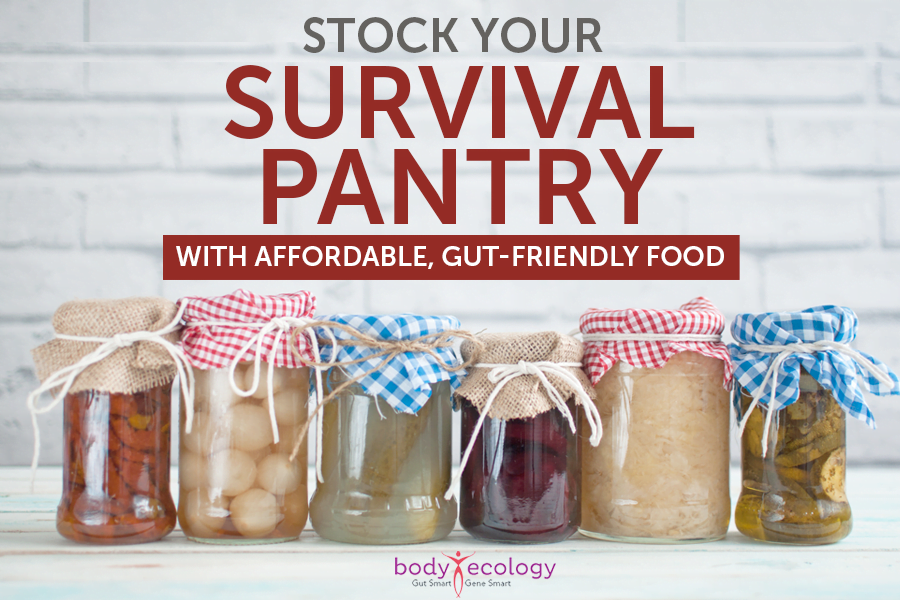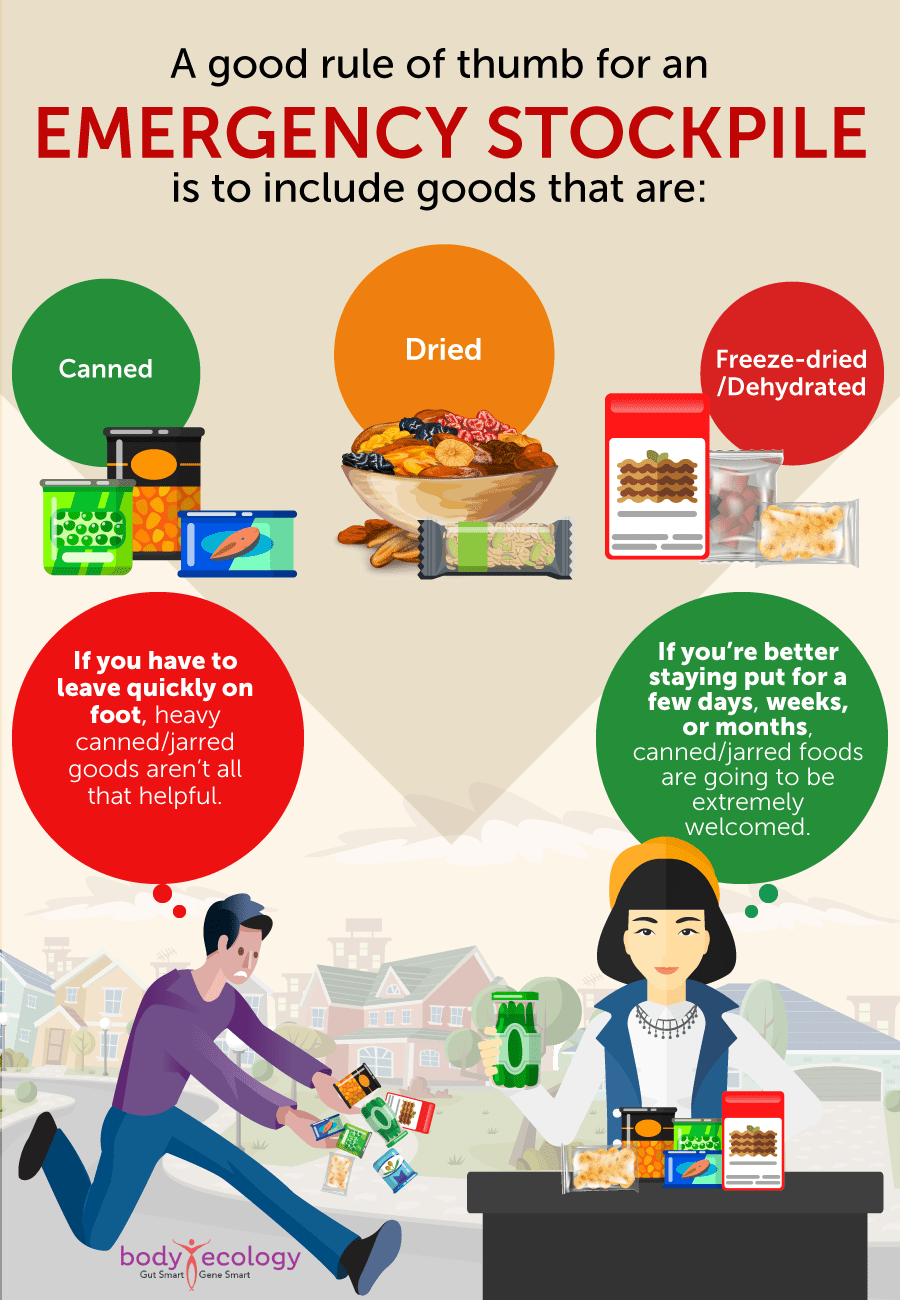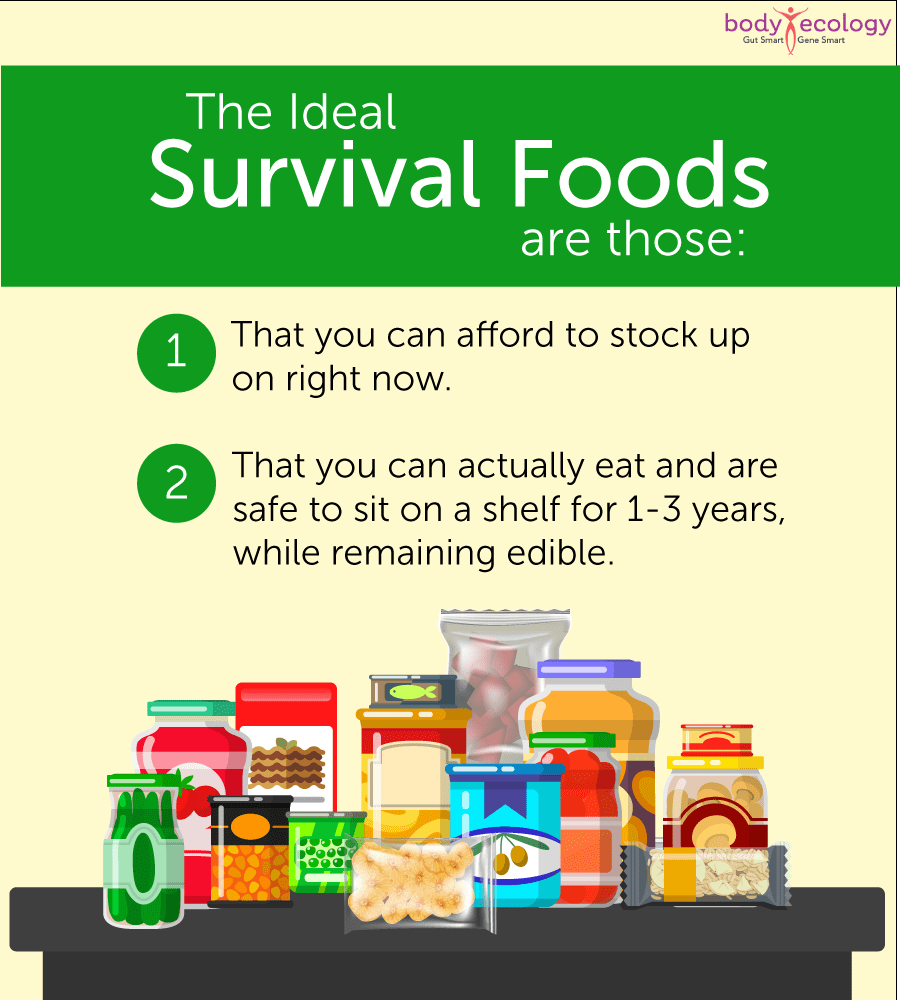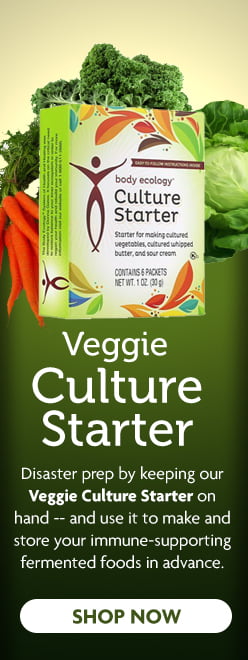
Stock your survival pantry with affordable, gut-friendly food
If you live in an area prone to or at risk for earthquakes, hurricanes, tornadoes, flooding, wildfires, or other disasters and crises, you may already have a survival kit.
Commercially prepared kits often include emergency rations, but these are rather bland packets of dried food that supply carbs, protein, and fat with some vitamins and minerals to tide you over until help arrives.
Given the potential for longer periods without outside assistance, many preppers are keen to start stocking up on a healthier storehouse of survival foods.
Indeed, if you’re likely to be sheltering in place, consider putting together a disaster pantry full of staples and foods with a long shelf-life that actually nourish and protect your mind and body, especially under stressful circumstances. (See below for a list of what to have handy.)
What kinds of foods should you stock in your survival bunker?
Let’s say you have to load up your car and leave quickly, and you were foresighted enough to have jars of homemade, fermented veggies in your refrigerator. If you grab a few jars and stuff them into a backpack before leaving on foot or a bicycle, you’ll be very glad you did — because these foods are survival foods extraordinaire.
In fact, our ancestors depended on fermented foods to survive long winters when no foods grew in their garden. Refrigeration, after all, is a very new tool for modern man.

And what’s more nutritious than fermented foods, such as kimchi, sauerkraut, and pickles? Because they’re fermented, they’re a wonderful source of beneficial nutrients and also beneficial microbes, helping to ensure a hardy immune system — necessary for survival. Fermented vegetables are a very good source of vitamin C, and you can make them even more mineral-rich by adding sea vegetables, like wakame, arame, and dulse.
Psst — here’s where you can find Body Ecology’s popular dill pickle recipe.
Fermented foods from your local grocery or health food store can certainly be part of your survival strategy, of course, but it’s more economical to ferment the veggies yourself. And what if going to a store is not an option? What if shipments of produce can’t make it through to the store? Or, computers are down, and the store has to close? What if riots are forcing the stores to lock up and turn customers away, or the store has been raided, and nothing is left on the shelves? What if it’s not safe to go out?
As unimaginable as this is to us, sometimes the unthinkable happens. Recently, what we’ve been watching on TV has many worried, and hundreds of thousands of people called “preppers” are beginning to prepare for harder times — just in case.
Consider a home or community garden:
- If you have a yard, start now to prepare the soil by composting using kitchen scraps and coffee grounds.
- There’s no shortage of information online telling you how to compost and plant a garden.
- Some of the easiest and best vegetables to grow for fermenting are cabbage (red and green), beets, carrots, daikon, turnips (and turnip greens), kale, collards, garlic, and ginger.
- With these, you can make a delicious variety of recipes.
- If you live in the city or in a home with no yard, gather your neighbors together and form a community garden.
This can mean it’s easier to survive and thrive on locally grown foods all year-round. Having ready-to-go cultures on hand, so you can pickle and preserve a glut of vegetables or fruit, can make for a more affordable, sustainable survival pantry. And in the short-term, it saves you buying the expensive readymade, overhyped survival foods that promise to keep you alive but certainly won’t nourish your microbiome and support healthy immune function.
Stocking up on home-fermented foods as survival foods offers an affordable and safe way to store food and prepare for disaster.
The top 15 foods to stockpile in your ‘prepper’ pantry
Good ideas for survival foods include:
1. Apple cider vinegar
2. Bulk grains – Need to be kept very dry and consumed within three to six months; mold can grow in grains when damp.
3. Bulk nuts and nut butters – Ideally, sprouted.
4. Canned fish – Especially wild-caught salmon and sardines.
5. Canned liquids – Coconut milk and vegetable juice.
6. Dehydrated vegetables and meat jerky – Cured without chemicals.
7. Dried beans and pulses – Non-irradiated, so you can sprout them for fresh food and to grow plants. My favorite is black-eyed peas because they’re low in oxalates, where lentils are very high.
8. Ghee and coconut oil – Do not need refrigeration.
9. Honey – Lasts forever, can help support immune function, and can be used topically.1
10. Our Veggie Culture Starter and Kefir Starter
11. Popping corn – Can also be ground to cornmeal flour as needed.
12. Premium sea salt
13. Sea vegetables – Great source of minerals and iodine. Purchase dried, in powder form, and add them to your cultured vegetable recipes.
14. Stevia, Lakanto, and BE Sweet™ (our new sweetener available in early summer)
15. Whole milk powder or in tetra pack – Ideally, from A2 Jersey cows, if possible.

Now just might be the time to become a prepper too. If catastrophe strikes, you and your community are likely to quickly run short on fresh produce. Stores will soon be left with overly-processed, packaged, sugary, fatty foods that may actively sabotage your ability to stay healthy under extreme stress.
Depending on the kind of calamity underway, it’s also possible a good source of iodine would be helpful. This mineral can help protect the thyroid against the negative effects of radiation and is present in sea vegetables that lend themselves well to long-term storage.2 Even better, ferment those sea vegetables using natural brine and have starter cultures available to preserve other fresh vegetables as you acquire them.
Beyond that, you’re going to want to plan to safely preserve fresh food you grow yourself, and that means fermentation. Now is the best time to start learning how.
Pickling and fermenting are hands-down the optimal ways to store or preserve food. Preserving is usually used as a catch-all term that covers any method of storing food long-term and can include smoking, fermenting, pickling, salting, and other strategies.
Preserves, however, are typically fruit-based foods — a bit like jam but with pieces of the fruit left intact rather than homogenized; preserves are made with fruit sugars, pectin, and/or gelatin and heat to kill potential pathogens.
Pickling involves the use of salt or brine to keep microbe growth in check and prevent food from spoiling. While this is certainly helpful for some foods and can be delicious, for many vegetables, fermentation is absolutely the way to go. Why? Cultured/fermented vegetables rely on the activity of beneficial microbes to preserve food by keeping less desirable, potentially pathogenic microbes in check.
Fermentation also makes many foods easier to digest. Fermented foods are rich in nutrients and help to maintain a healthy gut microbiome and a robust immune system.3 They are the true superfoods. An added bonus: With a well-balanced inner ecosystem in your gut, you’ll also have a more desirable gut-brain connection — at a time when you most need it.4,5
REFERENCES:
- 1. Ahmed S, Sulaiman SA, Baig AA, et al. Honey as a Potential Natural Antioxidant Medicine: An Insight into Its Molecular Mechanisms of Action. Oxid Med Cell Longev. 2018;2018:8367846. Published 2018 Jan 18. doi:10.1155/2018/8367846.
- 2. Steven L. Manley and Christopher G. Lowe. Canopy-Forming Kelps as California’s Coastal Dosimeter: 131I from Damaged Japanese Reactor Measured in Macrocystis pyrifera. Environmental Science & Technology 2012 46 (7), 3731-3736. DOI: 10.1021/es203598r.
- 3. Olivares M, Paz Díaz-Ropero M, Gómez N, Sierra S, Lara-Villoslada F, Martín R, Miguel Rodríguez J, Xaus J. Dietary deprivation of fermented foods causes a fall in innate immune response. Lactic acid bacteria can counteract the immunological effect of this deprivation. J Dairy Res. 2006 Nov;73(4):492-8. doi: 10.1017/S0022029906002068. Epub 2006 Sep 21. PMID: 16987435.
- 4. Kim, B., Minsu Hong, V., Yang, J., et al. (2016). A Review of fermented foods with beneficial effects on brain and cognitive function. Prev Nutr Food Sci, 21(4), 297-309.
- 5. Tillisch K, Labus J, Kilpatrick L, et al. Consumption of fermented milk product with probiotic modulates brain activity. Gastroenterology. 2013;144(7):1394-1401.e14014. doi:10.1053/j.gastro.2013.02.043.









